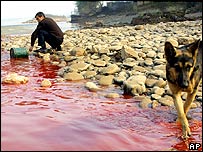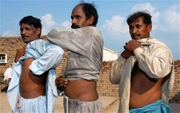Scientists study Earth's missing crustSANTA CRUZ DE TENERIFE, Canary Islands - British scientists have embarked on a mission to study a huge area on the Atlantic seabed where the Earth's crust is mysteriously missing and instead is covered with dark green rock from deep inside the planet.
The 12-member expedition to take an unprecedented peek at Earth's mantle left the Canary Islands on Monday with a new high-tech vessel and a robotic device named Toby that will dig up rock samples at the site and film what it sees.
The main site — there is at least one other in roughly the same area and a third is suspected — is about three miles below the surface of the Atlantic and located about 2,000 nautical miles southwest of the Canaries.
It is part of a globe-spanning ridge of undersea volcanos, the kind of structure that forms when Atlantic tectonic plates separate and lava surges upward to fill the gap in the Earth's crust.
But that apparently did not happen this time. Where there should be a four-mile-thick layer of crust, there is instead that much mantle — the very dense, dark green rock that makes up the deep inner layer of the Earth.
Scientists have seen chunks of mantle that have been spewed up with lava, but never such a large, exposed stretch.
"It is like a window into the interior of the Earth," Bramley Murton, a geophysicist who is taking part in the six-week mission, said Tuesday from the research ship RRS James Cook as it headed to the site, still five days away.
This exposed layer is irregularly shaped, about 30 miles long and perhaps that distance or more at its widest. It was detected about five years ago with sonar from a surface vessel.
There are two main theories as to what happened, Murton said: A fault ripped away huge chunks of crust, or in an area of crust-forming volcanoes, this area was mysteriously devoid of that outer material, Murton said.
Roger Searle of Durham University, one of the lead researchers, said the study aims to provide insight on everything from the chemistry of oceans to the mechanisms of how the Earth behaves under so much water.
The robotic device will land on the exposed mantle, deploy a drill, and dig into the rock to bring back samples.
The project is being financed by Britain's National Environment Research Council and the Department of trade and Industry's Large Scientific Facilities Fund.
 What I failed to mention is that it’s also darker in the mornings. It used to be quite light by 8:00 am but now it’s still quite dark at 8:00 am... So it looks like there has been a 1 hour shift, or rather, the Earth has shifted off its axis so that there is now a one hour difference in sunrise and sunset times.
What I failed to mention is that it’s also darker in the mornings. It used to be quite light by 8:00 am but now it’s still quite dark at 8:00 am... So it looks like there has been a 1 hour shift, or rather, the Earth has shifted off its axis so that there is now a one hour difference in sunrise and sunset times. 

 The coming times and Earth changes will not be easy as it will bring a total breakdown of society as we presently know it. These changes will not be affecting some other person or people in another part of the world, but will be happening on our personal doorstep where it can’t be denied unless denial is still your intent.
The coming times and Earth changes will not be easy as it will bring a total breakdown of society as we presently know it. These changes will not be affecting some other person or people in another part of the world, but will be happening on our personal doorstep where it can’t be denied unless denial is still your intent.

















